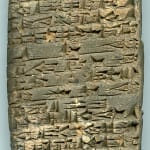Old Babylonian Terracotta Cuneiform Tablet, 1836 BCE
Terracotta
2.25 x 3.5
LO.1254
Further images
This tablet has a total of 20 lines of Sumerian cuneiform on the obverse and reverse, and has rollings of no less than seven cylinder seals to show the inscription...
This tablet has a total of 20 lines of Sumerian cuneiform on the obverse and reverse, and has rollings of no less than seven cylinder seals to show the inscription on them: the seven together on the reverse, and repeated on the edges: two on the upper edge, two on the lower edge, and the remaining three on the left-hand edge. It is dated to the first year of Zambiya, king of Isin in Sumer c. 1836 B. C.
Translation:
1/2 a ninda, 4 cubits length, 1 1/2 ninda width, its area 1 15 : an undeveloped plot of land adjacent to the house of Erra-qarrad, palace administrator:
Zambiya the king sold it to Beli-tayyar son of Patum. He (Beli-tayyar) weighed out for him (Zambiya) 12 1/2 shekels of silver.
Seal of: Ur-Shulpa’e, administrator of the date grove Erra-gasher, comptrolle Dadi, supervisor of the merchant banker Ur-dukuga Ili-kitt Ili-iddinash And Ilushu-ibbish rolled their seals.
Seal inscriptions:
Ur-Shulpa’ royal scrib son of Lu-Amar-Suen adminstrator of the date grove
Erra-gashe scribe of the kin son of Nanna-mansu servant of Enlil-ban
Ur-dukug son of Nuhhubu servant of (the god) Amu[rrum]
Ili-kitt son of Ilishka-utu Servant of (the god) Amurru
Ili-iddinash son of Humz servant of (the god) Amurru
Ilushu-ibbish son of Awil-Ishta servant of (the gods) Ninsi’ann and Kabt
Dad supervisor of the merchant banker servant of (the god) Daga and Enlil-ban
Month: Abu, year: Zambiya the kin
This is a rare and important document among real estate sale documents of the period. No less a person than the king (Zambiya, in his first year) sold an undeveloped house plot to a private person for 12 1/2 shekels of silver. This raised a legal problem: normally the seller took an oath in the king’s name, but the king could not of course do that! So seven witnesses were gathered, more than usual, and the first three were public officials. The seal inscriptions of two of these three indeed declare the owners officers of the previous king Enlil-bani. They had not yet got new seals with the new king’s name! But such ceremony is attested in one of these seals, that of Ur-Shulpa’e: it ascribes to him two offices: first “royal scribe,” then, at the end, “administrator of the date groves.” The first is a lower rank, the second much higher. Thus he was first royal scribe, later promoted to Administrator of the date groves. But the second was simply added on the seal without obliteration of the first, which would have resulted in a ghastly looking seal: weals were made of hematite in this period and were very expensive items.
The tablet is in very good condition: only very slight damage to the reverse. Some of the art of the seals is visible: standing gods and worshippers.
Description and translation kindly provided by Professor W. G. Lamber
Translation:
1/2 a ninda, 4 cubits length, 1 1/2 ninda width, its area 1 15 : an undeveloped plot of land adjacent to the house of Erra-qarrad, palace administrator:
Zambiya the king sold it to Beli-tayyar son of Patum. He (Beli-tayyar) weighed out for him (Zambiya) 12 1/2 shekels of silver.
Seal of: Ur-Shulpa’e, administrator of the date grove Erra-gasher, comptrolle Dadi, supervisor of the merchant banker Ur-dukuga Ili-kitt Ili-iddinash And Ilushu-ibbish rolled their seals.
Seal inscriptions:
Ur-Shulpa’ royal scrib son of Lu-Amar-Suen adminstrator of the date grove
Erra-gashe scribe of the kin son of Nanna-mansu servant of Enlil-ban
Ur-dukug son of Nuhhubu servant of (the god) Amu[rrum]
Ili-kitt son of Ilishka-utu Servant of (the god) Amurru
Ili-iddinash son of Humz servant of (the god) Amurru
Ilushu-ibbish son of Awil-Ishta servant of (the gods) Ninsi’ann and Kabt
Dad supervisor of the merchant banker servant of (the god) Daga and Enlil-ban
Month: Abu, year: Zambiya the kin
This is a rare and important document among real estate sale documents of the period. No less a person than the king (Zambiya, in his first year) sold an undeveloped house plot to a private person for 12 1/2 shekels of silver. This raised a legal problem: normally the seller took an oath in the king’s name, but the king could not of course do that! So seven witnesses were gathered, more than usual, and the first three were public officials. The seal inscriptions of two of these three indeed declare the owners officers of the previous king Enlil-bani. They had not yet got new seals with the new king’s name! But such ceremony is attested in one of these seals, that of Ur-Shulpa’e: it ascribes to him two offices: first “royal scribe,” then, at the end, “administrator of the date groves.” The first is a lower rank, the second much higher. Thus he was first royal scribe, later promoted to Administrator of the date groves. But the second was simply added on the seal without obliteration of the first, which would have resulted in a ghastly looking seal: weals were made of hematite in this period and were very expensive items.
The tablet is in very good condition: only very slight damage to the reverse. Some of the art of the seals is visible: standing gods and worshippers.
Description and translation kindly provided by Professor W. G. Lamber







